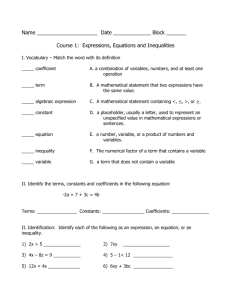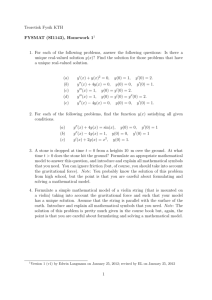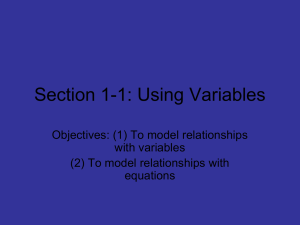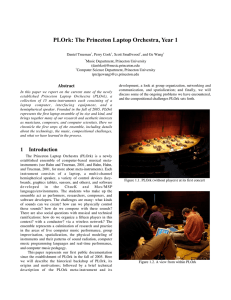End of Year Vocabulary Words and Definitions
advertisement
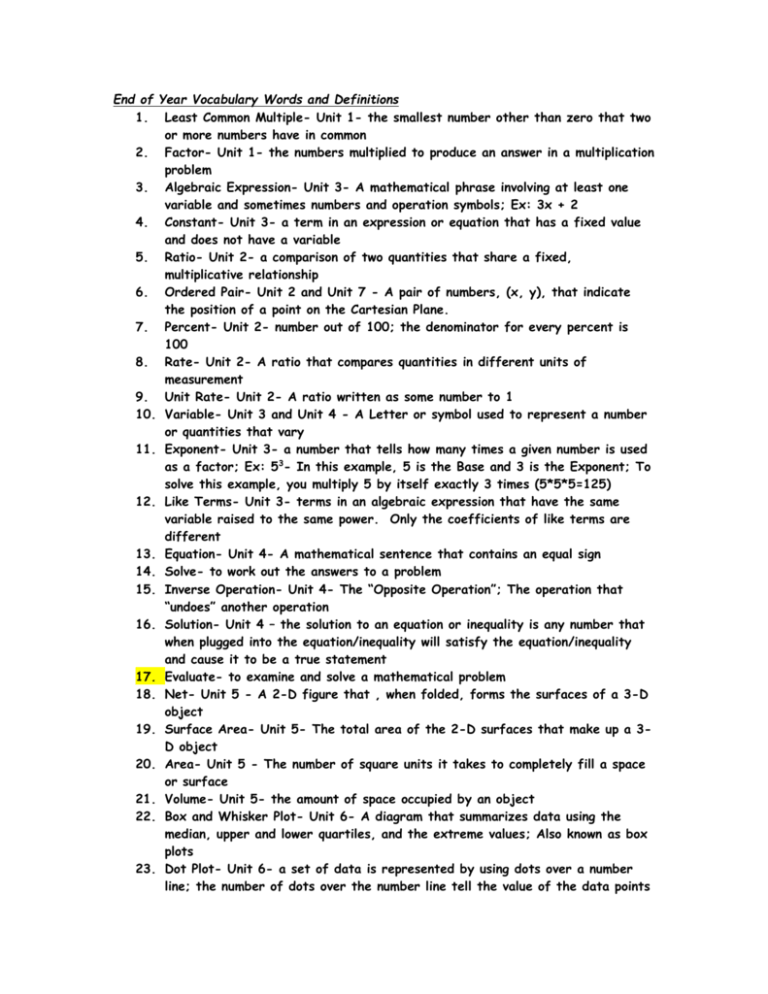
End of Year Vocabulary Words and Definitions
1. Least Common Multiple- Unit 1- the smallest number other than zero that two
or more numbers have in common
2. Factor- Unit 1- the numbers multiplied to produce an answer in a multiplication
problem
3. Algebraic Expression- Unit 3- A mathematical phrase involving at least one
variable and sometimes numbers and operation symbols; Ex: 3x + 2
4. Constant- Unit 3- a term in an expression or equation that has a fixed value
and does not have a variable
5. Ratio- Unit 2- a comparison of two quantities that share a fixed,
multiplicative relationship
6. Ordered Pair- Unit 2 and Unit 7 - A pair of numbers, (x, y), that indicate
the position of a point on the Cartesian Plane.
7. Percent- Unit 2- number out of 100; the denominator for every percent is
100
8. Rate- Unit 2- A ratio that compares quantities in different units of
measurement
9. Unit Rate- Unit 2- A ratio written as some number to 1
10. Variable- Unit 3 and Unit 4 - A Letter or symbol used to represent a number
or quantities that vary
11. Exponent- Unit 3- a number that tells how many times a given number is used
as a factor; Ex: 53- In this example, 5 is the Base and 3 is the Exponent; To
solve this example, you multiply 5 by itself exactly 3 times (5*5*5=125)
12. Like Terms- Unit 3- terms in an algebraic expression that have the same
variable raised to the same power. Only the coefficients of like terms are
different
13. Equation- Unit 4- A mathematical sentence that contains an equal sign
14. Solve- to work out the answers to a problem
15. Inverse Operation- Unit 4- The “Opposite Operation”; The operation that
“undoes” another operation
16. Solution- Unit 4 – the solution to an equation or inequality is any number that
when plugged into the equation/inequality will satisfy the equation/inequality
and cause it to be a true statement
17. Evaluate- to examine and solve a mathematical problem
18. Net- Unit 5 - A 2-D figure that , when folded, forms the surfaces of a 3-D
object
19. Surface Area- Unit 5- The total area of the 2-D surfaces that make up a 3D object
20. Area- Unit 5 - The number of square units it takes to completely fill a space
or surface
21. Volume- Unit 5- the amount of space occupied by an object
22. Box and Whisker Plot- Unit 6- A diagram that summarizes data using the
median, upper and lower quartiles, and the extreme values; Also known as box
plots
23. Dot Plot- Unit 6- a set of data is represented by using dots over a number
line; the number of dots over the number line tell the value of the data points
24. Mean- Unit 6 - The average or fair share value for a set of data; Also the
balance point of the corresponding data distribution
25. Median- Unit 6 - The value for which half the numbers are larger and half
are smaller
26. Mode- Unit 6 - The number that occurs the most often in a list; There can
be one of these or none at all
27. Measures of Center- Unit 6 - The Mean and Median are both ways to
measure the center for a set of data
28. Measures of Spread/Variability- Unit 6 - The Range and the Mean Absolute
Deviation are both common ways to measure the spread for a set of data
29. Statistical Question- Unit 6- a question used in surveys that anticipates
variability in the data
30. Integer- Unit 7 - The set of whole numbers and their opposites {… -3, -2, 1, 0, 1, 2, 3, …}
31. Rational Number- Unit 2 and Unit 7 - The set of numbers that can be written
in the form a/b where a and b are integers and b ≠ 0.
32. Inequality- Unit 4 and Unit 7 - Any mathematical sentence that contains the
symbols > (greater than), < (less than), < (less than or equal to), or >
(greater than or equal to).
33. Opposite Numbers- Unit 7 - Two different numbers that have the same
absolute value. Example: 4 and -4 are opposite numbers because both have an
absolute value of 4.
34. Negative Numbers- Unit 7 - The set of numbers less than zero
35. Positive Numbers- Unit 7 - The set of numbers greater than zero
36. Range- Unit 6 - A measure of spread for a set of data; Found by subtracting
the smallest value from the largest value in a set of data
37. Proportions- Unit 2- An equation that states that two ratios are equal
38. Distributive Property- Unit 3- The sum of two addends multiplied by a number
is the sum of the product of each addend and the number.
39. Associative Property- Unit 3a. Of Addition- The sum of a set of numbers is the same no matter how
the numbers are grouped (3+4)+5=3+(4+5); When all the symbols are
addition, the numbers can be grouped in any order and the sum will be
the same
b. Of Multiplication- The product of a set of numbers is the same no
matter how the numbers are grouped; Ex: (5*3)*6=5x(3*6); The product
will be the same no matter how the numbers are grouped as long as all
the symbols are multiplication
40. Commutative Property- Unit 3a. Of Addition- The sum of a group of numbers is the same regardless of
the order in which the numbers are arranged; Ex: 4 + 9 + 3= 9 + 3 + 4
b. Of Multiplication-The product of a group of numbers is the same
regardless of the order in which the numbers are arranged; Ex3*10*5=5*3*10


